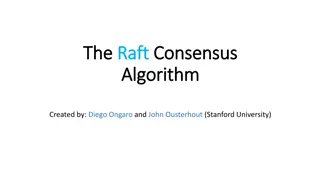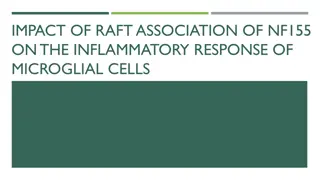Meticulous Research Unveils Lucrative Growth Trajectory for Aquaponics Market, Projecting USD 2.36 Billion by 2030
Aquaponics Market by System (Media Based Aquaponics, Raft System), Equipment (Grow Lights, Pumps & Valves), Facility Type (Glass Greenhouses, Indoor Vertical Farms), Product Type (Fish, Vegetables, Herbs, Fruits), Application - Global Forecast to 2030
6 views • 2 slides
Differentiated RAFT Strategies for Engaging Writing Across the Curriculum
RAFTs, an engaging high-level strategy, encourage students to assume roles, consider audiences, write in specific formats, and explore topics. This method motivates students by offering choice and aligning with their interests and learning profiles. Differentiating RAFTs by readiness involves assign
0 views • 15 slides
Understanding State Machine Replication in Distributed Systems Using RAFT
State machine replication is a crucial aspect of distributed systems, aiming to ensure reliability and fault tolerance. The RAFT protocol, based on the Primary-Backup mechanism, extends high availability by incorporating leader election and view change processes. This enables servers to behave as a
2 views • 41 slides
Raft Consensus Algorithm Overview for Replicated State Machines
Raft is a consensus algorithm designed for replicated state machines to ensure fault tolerance and reliable service in distributed systems. It provides leader election, log replication, safety mechanisms, and client interactions for maintaining consistency among servers. The approach simplifies oper
0 views • 32 slides
Windmill Hill East Sussex Trip Information for Parents
Important details for the Windmill Hill East Sussex trip from Wednesday, 25th to Friday, 27th March 2020. Includes information on staff attending, room allocation, activities, what children need to bring, and departure details. Children will be participating in activities like abseiling, raft buildi
0 views • 11 slides
Raft Consensus Algorithm Overview
Raft is a consensus algorithm designed for fault-tolerant replication of logs in distributed systems. It ensures that multiple servers maintain identical states for fault tolerance in various services like file systems, databases, and key-value stores. Raft employs a leader-based approach where one
0 views • 34 slides
Understanding the Importance of the Status of Allowance
Key terms related to the Status of Allowance (SOA) report are defined in this presentation, emphasizing its significance in tracking funds and obligations. The content covers the basics of SOA, balancing techniques, and its role in preparing financial reports for RAFT execution. Stay informed to man
0 views • 34 slides
Highlights of Legislative Session Presentation to RAFT
The presentation by Vanessa K. Hawker, Ph.D., Chief Strategic Advisor at University of New Mexico Health Sciences Center, covers the outcomes and proceedings of the legislative session, including statistics on bills, appropriation changes requested for FY16, types of legislation, and activities duri
0 views • 6 slides
Understanding the Raft Consensus Algorithm: Basics and Leader Election
Raft is a consensus algorithm designed by Diego Ongaro and John Ousterhout at Stanford University for practical systems. It simplifies understanding through leader-follower structure and terms for leader election. Nodes transition between Follower, Leader, and Candidate states, initiating elections
0 views • 21 slides
An Introduction to Consensus with Raft: Overview and Importance
This document provides an insightful introduction to consensus with the Raft algorithm, explaining its key concepts, including distributed system availability versus consistency, the importance of eliminating single points of failure, the need for consensus in building consistent storage systems, an
0 views • 20 slides
Interactive Lesson on RAFT Writing Strategy
Engage in an interactive session focusing on the RAFT writing strategy, covering topics such as narrowing down PSA topics, audience identification, writing formats, and filling out a RAFT template. Practice filling out a RAFT and understand the key components required.
0 views • 9 slides
Comprehensive Sponsored Programs Training Opportunities at UF
Explore a wide range of sponsored programs training opportunities at UF, including the RAFT Cohort, RAFT Forum, monthly RAFT Training Classes, RAFT Certificate program, and other specialized training programs covering various aspects of grants management and sponsored projects. From basic to advance
0 views • 12 slides
The Raft Consensus Algorithm: Simplifying Distributed Consensus
Consensus in distributed systems involves getting multiple servers to agree on a state. The Raft Consensus Algorithm, designed by Diego Ongaro and John Ousterhout from Stanford University, aims to make achieving consensus easier compared to other algorithms like Paxos. Raft utilizes a leader-based a
0 views • 26 slides
Understanding the Raft Consensus Protocol
The Raft Consensus Protocol, introduced by Prof. Smruti R. Sarangi, offers a more understandable and easier-to-implement alternative to Paxos for reaching agreement in distributed systems. Key concepts include replicated state machine model, leader election, and safety properties ensuring data consi
0 views • 27 slides
Impact of Raft Association of NF155 on Microglial Cells' Inflammatory Response
Multiple sclerosis (MS) is a neurodegenerative disease affecting millions globally by causing myelin loss in the CNS axons. This study investigates the role of NF155 raft association in the inflammatory response of microglial cells, shedding light on potential treatment strategies for MS. Liposome t
0 views • 9 slides
Enhancing Distributed Consensus: Combining PBFT and Raft for Improved Security
Addressing challenges in distributed systems, this study proposes a novel approach by combining PBFT and Raft consensus mechanisms to enhance scalability and fault tolerance. The research highlights the importance of secure data storage and identifies new attack mechanisms in today's digital landsca
0 views • 11 slides
Structural Design and Analysis of 60-story Building Using Ultra-lightweight Floor Systems
This project involves the structural design and analysis of a 60-story building constructed with ultra-lightweight floor systems. The study focuses on comparing the CLT floor system with traditional RC floor systems, evaluating overall structural performance using ETABS software, and assessing found
0 views • 19 slides
Understanding Strong Consistency and CAP Theorem in Distributed Systems
Strong consistency and the CAP theorem play a crucial role in the design and implementation of distributed systems. This content explores different consistency models such as 2PC, consensus, eventual consistency, Paxos, and Raft, highlighting the importance of maintaining ordering and fault-toleranc
0 views • 29 slides
Understanding Strong Consistency and CAP Theorem
Explore the concepts of strong consistency, CAP theorem, and various consistency models such as 2PC, consensus, eventual consistency, Paxos, Raft, and Dynamo. Learn about fault-tolerance, durability, and the importance of correct consistency models in distributed systems. Understand how Paxos and Ra
0 views • 29 slides
Complete Guide to Bridge Foundations and Substructures
Explore the various components of bridge construction such as foundations, substructures, and superstructures. Learn about the different types of bridge foundations including spread, raft, grillage, inverted arch, pile, well, and caisson foundations. Discover the functions of bridge foundations in c
0 views • 16 slides
Raft: A Consensus Algorithm for Replicated Logs Overview
Raft is a consensus algorithm developed by Diego Ongaro and John Ousterhout at Stanford University. It aims to ensure replicated log clients and consensus modules maintain proper log replication and state machine execution across servers. Raft utilizes leader election, normal operation for log repli
0 views • 31 slides




















